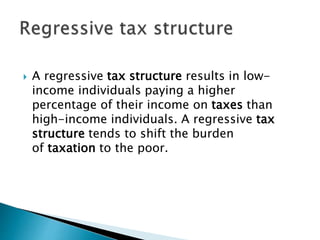Tax structure in developing countries
- 1.
- 2. Economics of developing countries- M.Com. sem2
- 3. “Fiscal policy refers to policy under which govt. uses its expenditure and revenue programmes to produce desirable effects and avoid undesirable effects on the national income , production and employment”……Arthus Smithies Fiscal policy in short refers to budgetary policy.
- 4. Accelerating Economic Growth Price stability Reducing income inequalities Generating employment opportunities To mobilize resources To encourage socially optimal investment
- 5. Public revenue Public expenditure Deficit financing Public debt
- 6. The income of the government through all sources is called public income or public revenue. ... According to Dalton, however, the term “Public Income” has two senses — wide and narrow. In its wider sense it includes all the incomes or receipts which a public authority may secure during any period of time.-
- 9. There are variety of taxes like direct and indirect tax, progressive, proportional and regressive taxes, VAT, GST, Purposely selected collections different types of tax to achieve desired objective is known as tax structure of a country.
- 10. Low tax revenue as % of GDP High tax rate for income tax and corporate taxes Absence of agricultural taxation tax evasion Regressive tax structure frequent changes in types of taxes and tax rate
- 11. As % GDP it is very low in developing nations LOW PCI Greater inequalities No tax on Agricultural sector
- 13. Name of countries MALASIYA 6.4 INDIA 17.7 CHINA 21.1 AUSTRALIA 34.3 CANADA 39.8 DENMARK 50.8 NORWAY 54.8 Tax revenue % of GDP
- 14. 3.25 per cent in 2000-01. 6.3 per cent in 2007-08 5.47 per cent in 2015—16. Share of direct taxes to GDP touched a peak of 6.3 per cent in 2007-08 and has since declined to 5.47 per cent in 2015—16. It was 3.25 per cent in 2000-01…..P.M. Modiji
- 17. A regressive tax structure results in low- income individuals paying a higher percentage of their income on taxes than high-income individuals. A regressive tax structure tends to shift the burden of taxation to the poor.
- 19. Taxpayers fall into one of seven brackets, depending on their taxable income: 10%, 15%, 25%, 28%, 33%,35% or 39. 6%. Because the U.S. tax system is a progressive one, as income rises, increasingly higher taxes are imposed. But those in the highest bracket don't pay the highest rate on all their income. Jan 12, 2018
- 22. Every year, the world's economies lose billions of dollars to tax avoidance. Estimates of the sheer scale of the losses fluctuate wildly with the IMF reporting that around $600 billion is lost due to profit shifting every year. The IMF has reported that OECD countries lose approximately 2 to 3 percent of their total annual tax revenue while lower-income countries lose substantially more.
- 23. Corruption Inefficient employees Illiterate population Lack of loyalties as citizen
- 25. High tax rate for income tax and corporate taxes Absence of agricultural taxation tax evasion Regressive tax structure frequent changes in types of taxes and tax rate
- 26. Tax rate –income tax and corporate taxes Progressive tax system Promoting savings and investment Simple tax structure Govt. revenues should increase Tax on agriculture Stability in tax rate and types
- 27. Explain features of tax system of developing nations. What are weaknesses of tax system of developing nations? What are the steps to improve?


























